Welcome to FISH FOOD TIMES
May. 2018 issue No.173

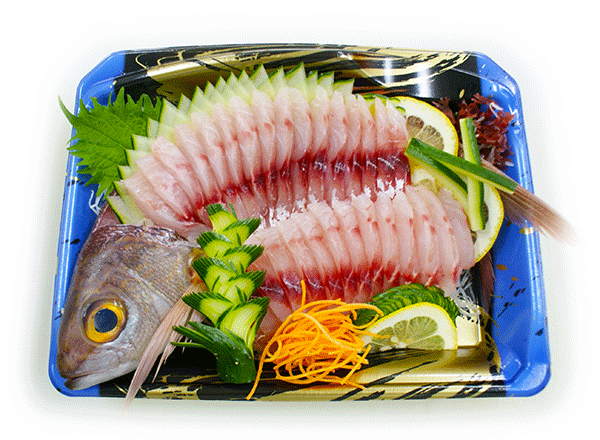
Lavender jobfish figure sashimi
Lavender jobfish is one of the representative fish of Okinawa
The generic name of Lavender jobfish is a southern system white fish inhabiting a relatively warm sea called kurukinmachi in the Okinawa region, inago in the Amami Islands, ogo in the Ogasawara Islands and komasu in Hachijo Island.

Lavender jobfish(Kurukinmachi)
There are fish called Seaperch which are very similar to Lavender jobfish, but the fish which is compared well with Lavender jobfish called kurukinmachi in Okinawa is Blue fusiliner (shicyumachi), in Okinawa it is kurukinmachi or sicyumachi, or Longtailed red snapper ( Akamachi) are fishes that have the name of machi and are compared.

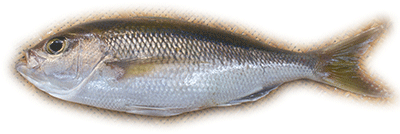
Longtailed red snapper(Akamachi) Blue fusiliner(shicyumachi)
The price traded in the Okinawa market is usually high in the order of Longtailed red snapper (Akamachi), Blue fusiliner (shicyumachi) Lavender jobfish (Kurukinmachi), and the value is Lavender jobfish (Kurukinmachi) as the lowest position . Given the reason, Longtailed red snapper (Akamachi) is one of Okinawa's three largest luxury fish with Akajin (Redspotted rockcod), Makubu (Blackspot tuskfish), and its red color presence is highly appreciated. Moreover, Blue fusiliner (shicyumachi) is a typical fish with natural taste like fish and it seems to be because it is evaluated that it is somewhat greasy as compared with Lavender jobfish (Kurukinmachi).
Research results that Lavender jobfish (Kurukinmachi) has its spawning eggs in May to July and 85% mature at 2 years of age are announced. The period until Lavender jobfish (Kurukinmachi) reaches the mature size is shorter than Longtailed red snapper (Akamachi), Blue fusiliner (shicyumachi), and since the growth rate of Lavender jobfish is fast, the catch in 2011 in Okinawa Prefecture is It was 139 t more than the other 2 fish species. Also because the fish body is not so big, it is easy to purchase because the price per fish is low, it is in the most popular position among fish called machi.
Also eat delicious leftover fish scraps
In Okinawa, we often eat white fish such as Lavender jobfish as fish soup like the underlying image. Okinawa has a food culture where miso soup becomes the main dish when rice and pickles are added to a lot of soup of sizes such as bowls rather than small bowls. And old fish soup first puts fish in the water, boils until it collapses as it is, and umami ingredients are pulled out from the bone.
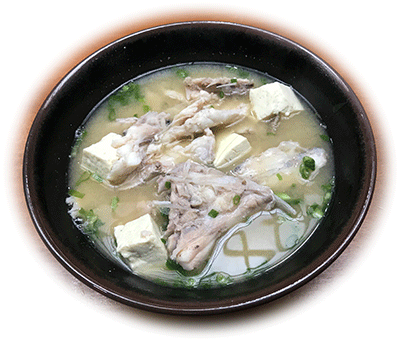
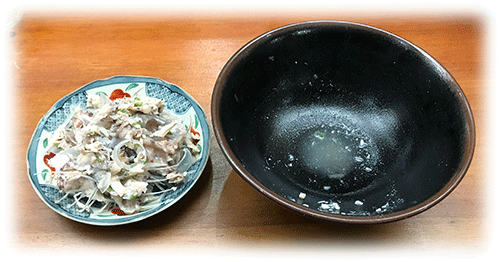 Lavender jobfish's fish soup Fish bone that remained after eating fish soup
Lavender jobfish's fish soup Fish bone that remained after eating fish soup
Lavender jobfish is often chosen by the people of Okinawa as a material of that soup. For example, unlike those who do not know how to eat fish living in the mainland, unlike the avoidance of heads and middle bones as unnecessary, on the contrary when selling white fish slices at Okinawa fish shops, The product of Okinawa is more pleased with the product with the middle bones and head attached as in the image.
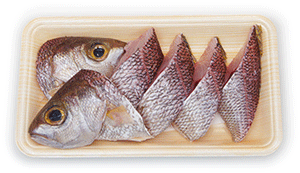
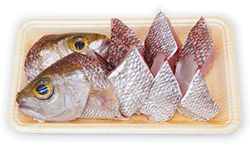
Lavender jobfish's fish slices
In Okinawa, even if the fish are small, not only selling it together with the fillet without throwing away the head, but also when the fish body is big fish and it is impossible to put the head together with the fillet as it is, all parts are small cut it and sell it as leftover fish scraps. Since there is a food culture that positively utilizes leftover fish scraps like this, leftover fish scraps sell better than the mainland. For example, in a supermarket in Okinawa, a farming fish producer buys a head separately when processing a vacuum yellowtail or a fillet of Greater amberjack and sells them in large quantities in the shop leftover fish scraps sell better It is.
Even though you can admit that the food culture of Okinawa is made mainly of pork, on the other hand, the way to eat good taste by using the head and bone is rooted. This is a pretty preferable event compared to the fish separation phenomenon caused by indifference to the fish and ignorance on the mainland, and it can be said that this is how to eat delicious fish in true fish.
In the past FISH FOOD TIMES April 20, issue No. 136 in the past what I meant to eat fish delicious originally, I wrote as follows.
| From FISH FOOD TIMES Heisei 20 - April issue No.136, a part of the sentence is extracted |
|---|
In order to eat fish deliciously, rather than escape to a way of eating like avoiding fish bones, it is more important to cook the umami ingredient from the bone, like miso soup of leftover fish scraps. But in Japan now, because the fish "umami" is not well understood, Japanese consumers are swayed by the "easy and convenient goods produced at the factory" fish dish called "fast fish" It seems to me that it is headed towards being in a direction. What is "umami" in the first place? Looking at reference materials ... In 1908, already over 100 years ago, Professor Ikeda of Tokyo Imperial University found that the identity of the taste of konbu dashi is glutamic acid. And he named "umami" as its "fifth basic taste" its taste which can not be explained with four basic tastes of sweetness, salty taste, acidity and bitter taste. Professor Ikeda obtained a patent for its seasoning based on glutamic acid and "Ajinomoto", a seasoning of umami, was released from Suzuki Pharmaceutical Co., Ltd. (now Ajinomoto Co., Ltd.) in May 1909 It was done. Today there is no word for this "umami" in English, so "umami" is being used internationally as a scholarly term. But in the 1980's it was finally found that there was an organization that felt umami ingredients in the tongue and then it got accepted globally as a "fifth taste". About 80 years since the discovery of umami, western researchers said that "umami" is a sense that appears as a harmony of four basic tastes, not a basic taste. In Japanese cuisine, after taking dashi with kombu, we use dried bonito to take dashi, but it is much stronger to combine konbu's amino acid type glutamic acid and dried bonito nucleic acid system inosinic acid than each one It comes from the experience value of the chef who knows that it will be able to obtain umami. In other words, if you cook together vegetable foods such as konbu which contains abundant inosinic acid and glutamic acid and guanylic acid of shiitake mushrooms, umami will become very strong. And umami is characterized by its calm taste and long aftertaste compared with other basic taste. The miso soup that Japanese people have eaten every morning from long ago is mixed with miso containing plenty of vegetable glutamic acid and irico rich in animal inosinic acid, and it becomes that delicious taste. If Ikko does not come out in the midst of every morning miso soup to make it a hidden taste, leftover fish scraps is different from irico in that it is "the main character that appeared in the table" and it is different, It is only the shape of leftover fish scraps rich in inosinic acid and glutamic acid of vegetable miso reversed. The quickest way to perceive the taste of miso souce sensibly is that the dashi soup umami traveled to Western countries that are not the base of cooking for more than a week and during that time they cook Japanese food such as miso soup It is not to eat. And I want you to drink the usual miso soup at home the next morning after returning home. If you drank miso soup while tasting the taste on the tongue, maybe you should be deeply moved by saying, "Miso soup was so tasty ... good!" In order for someone to say "good!", It is necessary to draw out the umami ingredients of the fish well, so that consumers who do not know the fish well and do not want to do the troublesome thing , It is important that we do not assentation. I think that the seller has to tell the consumer how to really eat fish deliciously. "Consumer's stupidity policy" named First Fish only makes a housewife who carries daily cooking lazy, and it seems that it will not lead to knowing the authentic taste of fish. I believe that such a "temporary expedient to the spread of fish catering" does not lead to upward consumption of fish the other way. Furthermore, with regard to the seller who sells fish, how to inform the customer that selling fish fillets at a cheaper price such as 100 Yen, rather than using their heads, I want you to think about whether it is good. A busy fish shop boasting consistently stable sales, in order to grasp customers who will bring stable sales in the future, rather than making temporary foam sales with short-term cheapness no matter what the economy in the world is It seems to be a store that continues "genuine-oriented business" that provides high quality products to the steady, although selling prices are somewhat higher. "Genuine-oriented" is not the same meaning as the word of luxury, there is know-how that you can teach to customers that you know the basic technique of utilization that neither fish head nor leftover fish scraps do waste as basic, I think that it refers to the store that actually stocks them as products. If there are a lot of people who do not know the authentic taste of the fish in your shop, it is not recommended for convenient and easy manufacturer's goods for such customers, but fresh seafood fish In addition, it is important to assemble genuine-oriented fish of high quality, teach the goodness of the goods to the customers to the good, and such continuous efforts will lead to big sales ahead It will be connected. |
As noted above, the author should review the "importance of making the best use of all of fish" again, also related to the sales of fish which is the main reader of FISH FOOD TIMES, I intended to mention at that time that I want you to tell consumers firmly as a position.
The merits and demerits of figure sashimi
There is a symbolic thing in the sense that it makes full use of the fish. It is "figure sashimi". Figure sashimi like the image below is a sashimi technique is "an aesthetic work gathered in a small one world", not only the taste aspect of sashimi, but also to express the beauty, except for the internal organs of the fish It can be said that it is a beautiful product that makes use of skill and skill using the most part of the site.
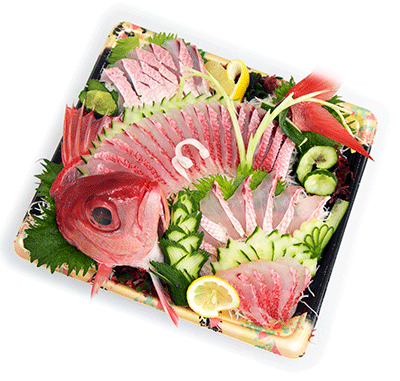
Longtailed red snapper (Akamachi) with hot water on the skin figure sashimi
However, there seems to be an understandable consumer who has decided that the figure sashimi is wastefully decorated. It is an idea that the essential head of the figure sashimi, the backbone, tail fin etc. only generate waste and they are not necessary because they are obstructive decorations.
Perhaps it seems to be a "housewife-like rational idea" to reduce garbage as much as possible as a daily consumer, but this is exactly "too outspoken" idea, which has been respected from long ago in Japan It is a shallow thinking that can not understand what is called "taste and elegance".
People who can only figure out the figure sashimi think that they are living by giving top priority to efficiency and rationality, acting without considering the viewpoint of "whether it is beautiful" in all of their lives .
For those who prioritize efficiency and rationality, the aesthetic decoration of figure sashimi may be wasteful. But on the other hand, if you look at the preferred eating habits of using fish heads and bones in Okinawa without throwing away, this can also be said to be 'reasonable in the opposite sense'. In other words, heads and bones which originally can not be thrown originally are added without being thrown away while being useful for "realization of beauty", so that can also be made up of plus alpha It is.
So, for Okinawans it is supposed that the head and bone of the fish are attached to the product in figure sashimi, so if the selling price is not particularly high, it can be spread as a product that is highly welcomed. However, seeing figure sashimi at Okinawa fish shops can not be expected with a probability close to 100%.
The reason is clear. Since Okinawa's sashimi has been based on a method that does not use radish for a long time, it uses shredded Japanese radish abundantly to draw skill. Because figure sashimi does not exist as one of the ideas of commercialization. The radish of winter vegetables to be used as a natural sashimi in the mainland was one of the difficult vegetables to get in the temperate Okinawa land from long ago, so sashimi without shredded Japanese radish was mainstream . In such an environment Okinawa not only figure sashimi but normal sashimi products as well as shops like anything under the shredded Japanese radish is not used sashimi normally, so after all it uses a lot of shredded Japanese radish figure sashimi It is impossible to see.
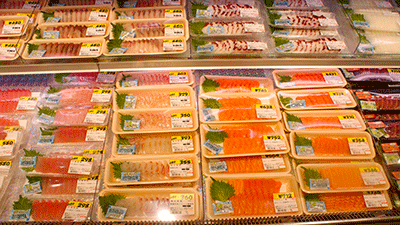
About 100% of sashimi technique that is common for a long time since it is hiratukuri sashimi, it is only arranging it horizontally on a flat tray, so there is no big difference in finished sashimi of any store. So it will be difficult to differentiate other shops from other companies with added value of sashimi, and if you try to win with sales of sashimi rather than competing stores you will have to run to volume and price competition by yourself.
The author has been in the supermarket division in Okinawa for 11 years now, but the guidance point is to establish high value-added products that do not require price competition, and how to make another company I have taught the company so far with in mind whether to finish it to a level that can not catch up with.
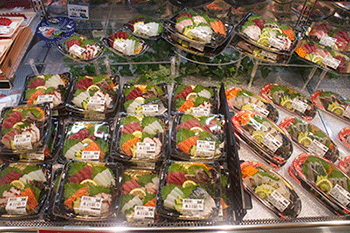
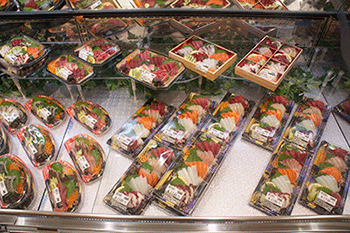
As one of them, we have strongly promoted "sashimi using shredded Japanese radish" which can realize technological differentiation for sashimi products with the fisheries department. As a result, the supermarket that the author is teaching does not tolerate the other in comparison with any mass retailers in Okinawa Prefecture, especially for the products of "large sashimi" which can not add value without using shredded Japanese radish I think that it has become a dominant level.
The reason for making such judgment is that shops that do not display sashimi products using shredded Japanese radish almost every day at Bon Festival or New Year, suddenly entered 15 sashimi neta using shredded Japanese radish suddenly It is because you can not make a big sashimi well. Shredded Using Japanese radish to skillfully arranging sashimi is not a very simple technique even if it seems easy, it is one of the very delicate and deep techniques.
Like the above image, the super fish shop where the author is teaching is shredded Japanese radish used sashimi is much more abundant than other shops. But if you say that figure sashimi is lined up well, there are no such facts unfortunately. If figure sashimi like the top image at the top of the page were stocked, it would be a fascinating fish selling space by clearly striking out the difference with other stores of other companies just by having it.
Fifth taste fifth color
To explain the process of making Lavender jobfishfigure sashimi of its First page image,
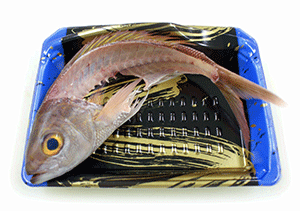
1, The head and tail fin lay one backbone three-dimensionally from the left oblique bottom of the tray to the right back.
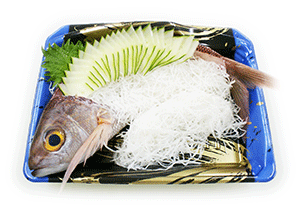
2, Arrange leaves of perilla and cucumber slices on the middle bone, shredded Japanese radish into a horizontally elongated trapezoid and serve in two stages.
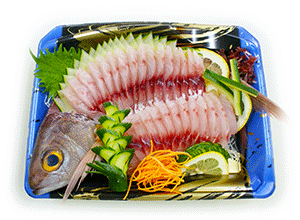
3, The shredded Japanese radish of the first row, the hiratsukuri sashimi of the upper body is lined up horizontally, and the hiratsukuri sashimi of the lower body is settled in the second shredded Japanese radish.
In this way I make figure sashimi, but figure sashimi must emphasize the appearance as well, so not only to serve fish but also to shredded Japanese radish as a bouquet, If you do not decorate beautifully with leaves of perilla, cucumber, lemon, carrot,seaweed, etc, you can not express its value. Long tailed red snapper (Akamachi) is a figure that is found in the previous image and decorated slightly excessively, and a relatively simple example is Lavender jobfish (Kurukinmachi).
These are accompanied by the following image "ashirai".
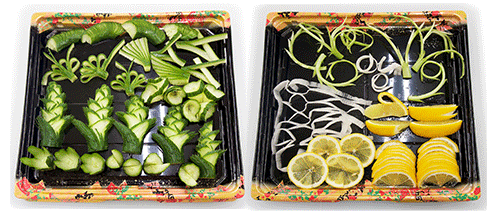
In the above image, there is no slice with half a cucumber, but this is the most basic, easy to use and useless technique among the cucumber treats, which is the last month's FISH FOOD TIMES Heisei era April, No. No. 172 , I will introduce the process of making the remedy in the image, so please refer to this.
The Japanese cuisine is said to be based on the fifth taste fifth color, but the five tastes are sweet, sour, salty, bitter and umami, the fifth color is white, red, yellow, green, black, The Japanese food expresses its beauty so that the dish looks delicious by effectively arranging this fifth taste fifth color.
For example, the following image is a work called "assorted natural red seabream figure sashimi" using only a small natural red seabream for half. Even though these ashirai are discreet, they are more luxurious than the Lavender jobfish figure sashim of the top image by adding various taste of the fish (fifth taste) and color (fifth color), feeling that this person seems to be enjoying variously and feeling more delicious .
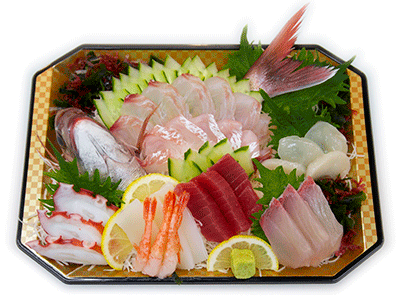
Like this image, sashimi products that are somewhat cumbersome to settle the technique presupposing the fifth taste fifth color are rational and efficient just arranging them in an efficient tray that is irrelevant to anything everyone can understand that there is a clearly big difference with a sashimi product.
In order to increase the sales of sashimi products at fish shops, it is a rational and efficient way to hit the wall of sales immediately from the limit of the technique, depending on the method of putting out volume or cheapening after all I think. However, if you have the power to create products like the above image, it is not impossible to produce wisdom by further advancing techniques further than this, and there is still limitless possibilities.
If you stand on the premise of "getting tired", keeping out methods that will not make your customers get bored will lead to continued growth in sales, so you can only change products according to your needs "Know-how and skill" of each other.
Although there were predecessors who shot down that "retail trade is a change adaptation industry", we want people to firmly tackle fish retailers so that they can respond to the taste of changing and tiring customers.
An opinion and the communication are to iinfo@fish food times
Date of updating 1 May. 2018
